

Did you know Indonesians are buying portable welding machines like never before? It's a shopping frenzy that has everyone talking. From small business owners to DIY enthusiasts, these compact machines are flying off the shelves faster than you can count.
This rush isn't just a trend, it's a movement reshaping industries. As global demand for quick, on-the-go solutions increases, portable welders have become more essential than ever. But what's driving this urgency? The answer is more surprising than you think.
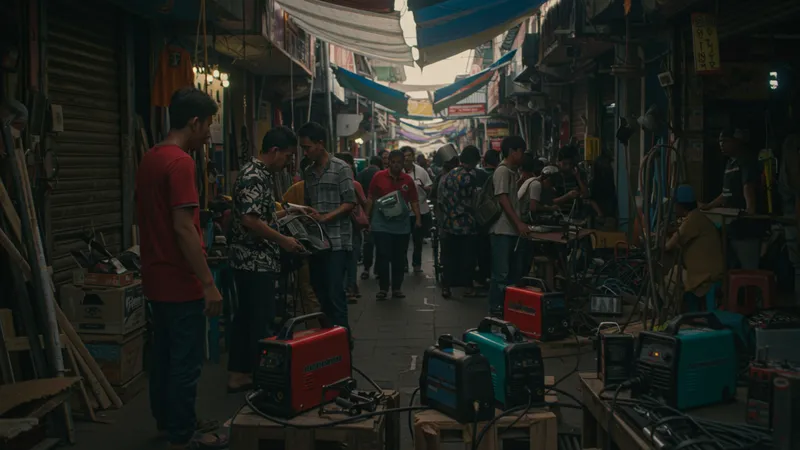
Indonesia's welding revolution isn't just about machines; it's about economic transformation. Small enterprises are using these welders to unleash creativity and innovation. From local artisans crafting unique metalworks to startups that weld as they expand, these machines are the real game changers. But that’s not even the wildest part…
Digging deeper, we find that these machines are powering a cultural shift. In regions where traditional jobs are evolving, the portable welder is a symbol of independence. Teens are mastering the craft, turning it into a lucrative side hustle. The implications for the economy are immense, and it’s becoming a potential solution to the unemployment crisis. But wait, there’s more…
The surge has experts scratching their heads. Why are people so eager for portable welders, and what happens next? As we dive deeper into this phenomenon, brace yourself for revelations that might just blow your mind. What happens next shocked even the experts…
The impact of portable welding machines on the Indonesian economy is profound yet surprisingly understated. These devices are driving a new wave of small business expansions, allowing entrepreneurs to enter markets they never dreamed possible. With the increase in availability, more people are turning their hobbies into profitable ventures, providing a much-needed boost to local economies. But there's a twist: many of these business owners are finding new ways to collaborate, forming networks that enhance productivity and innovation. This synergy is crafting a new economic landscape driven by shared expertise and resources.

Moreover, the government is taking notice. Recognizing the economic potential, there have been talks of initiatives to support small welding businesses through grants and training programs. However, the reality presents its own set of challenges. Issues like access to raw materials and fluctuating market demands make the sustainability of this trend questionable. Yet, innovators are devising unique solutions to keep the wheel turning. Community-led fabrication shops are emerging, providing resources and opportunities for further growth. But here’s another unexpected angle: some of these networks are making waves internationally.
Surprisingly, these local enterprises are catching the attention of global investors, keen on backing a movement that embodies adaptability and entrepreneurship. As these investors fund more projects, bigger plans emerge: from exporting high-quality metal goods to establishing training centers that teach new skills, these developments are turning heads worldwide. The collaboration between indigenous technology and international partnerships is setting the stage for groundbreaking market shifts. But the plot thickens as international agreements could alter the course yet again.
Yet, what’s truly staggering is the cultural shift this movement is spearheading. In many communities, traditional jobs are becoming obsolete, replaced by modern craft-based occupations powered by these machines. There's a growing pride in this newfound craftsmanship, challenging old stereotypes and empowering more individuals to pursue craftsmanship. As the movement forges ahead, there's a looming question: will the cultural revival sustain itself, or is it a fleeting phase? The answers may be more controversial than they appear…
In the remote villages of Indonesia, portable welding machines are proving to be powerful tools of empowerment. Typically detached from mainstream economic activities, these communities are now part of a ripple effect bringing technology and opportunity to their doorstep. The introduction of welding machines has allowed locals to tap into new forms of income, diversifying their economic activities beyond traditional farming or fishing. Interestingly, this technological wave is bridging a digital divide, paving paths for learning and innovation. As villagers embrace these tools, a new culture of ingenuity and self-reliance emerges, promising to reshape rural livelihoods.
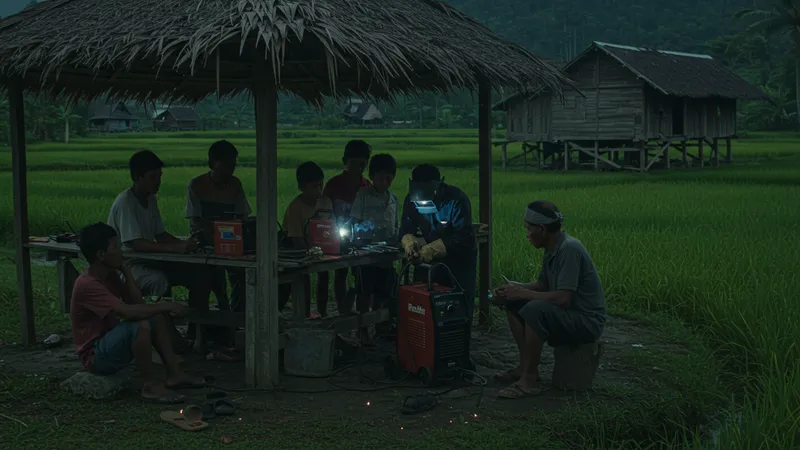
Educational workshops around these machines are becoming increasingly popular, assisting villagers in acquiring skills that were once inaccessible. Local organizations are stepping up, organizing training sessions that transform eager participants into proficient welders. The integration of such educational initiatives has a ripple effect, sparking interest in technological upskilling that extends beyond welding. However, the real challenge lies in adapting these skills to market needs, ensuring sustainable employment. Yet, these communities are demonstrating resilience and a willingness to evolve, overcoming barriers with surprising dexterity.
Furthermore, the environmental ramifications of these developments are intriguing. Communities that traditionally relied on environmentally taxing practices are shifting towards more sustainable and eco-friendly endeavors, significantly reducing their carbon footprint. This shift is gathering attention from environmentalists, sparking dialogue on the potential of tech-driven sustainability in rural areas. What started as simple entrepreneurship is now at the forefront of an environmental crusade, and it’s captivating audiences worldwide. But there’s a looming question: can these environmental gains be preserved as demand continues to grow?
Though the progress made is commendable, it’s not without challenges. The need for consistent electricity, quality tools, and sustainable financing models is critical in ensuring long-term success. Local governments and NGOs play a pivotal role, but their outreach and impact are still limited. Yet, there’s hope on the horizon. The potential integration of renewable energy technologies with these innovations suggests a future so promising that it warrants keeping a close eye on the developments. Will they unlock the true potential of these welding machines in rural Indonesia? The unfolding story might just redefine expectations…
Among Indonesia's youth, a new breed of entrepreneurs is emerging, driven by the allure of portable welding machines. These young visionaries are transforming garages and backyards into buzzing hubs of creativity and business innovation. With affordable entry points, welding machines have become the launchpad for those daring to pursue unconventional career paths. They're forging careers in fields as diverse as automotive repair, art installations, and customized metalworks. However, it’s not just about the machines; it's the entrepreneurial spirit that’s catching everyone’s attention. But what makes this youth movement different from others?

The answer lies in their creative approach to market challenges. Unlike older generations, these youth are more tech-savvy, leveraging social media to market their skills and expand their clientele. Platforms like Instagram and Facebook have become essential tools for showcasing their craftsmanship to a global audience. With the internet at their disposal, they are dismantling geographic boundaries, positioning themselves as critical players in a global marketplace. There's also a strong sense of community, as they form online collectives to share resources, techniques, and international opportunities. But it’s the stories behind their motivation that are truly transformative.
For many, these enterprises represent more than just financial gains; they are a pathway to expressing creativity and showcasing Indonesian heritage. Cultural identity plays a vital role as young entrepreneurs incorporate traditional designs into their modern creations, providing a unique fusion that captivates both local and international buyers. These products tell tales of a rich history, sparking a sense of pride and reinforcing cultural roots. Moreover, some are using their success to further social causes, proving that entrepreneurship can drive positive societal changes. Yet, there's debate on whether this model of growth has long-term viability.
Even amidst this success, there are challenges these young entrepreneurs must navigate. Issues of scalability, competition, and quality control pose significant hurdles. However, mentoring initiatives are slowly gaining traction, providing guidance and support to these budding business leaders. Institutions are now beginning to recognize the economic potential of this trend, discussing ways to integrate it into broader development strategies. As this movement continues to grow, a crucial question remains: will it inspire future generations to redefine success and reshape Indonesia’s economic landscape? Our next insights may hold the answers.
Portable welding machines in Indonesia are not only a catalyst for economic and cultural shifts but are also changing the very standards of craftsmanship through technology. As demand for precision and quality climbs, welding machines are integrating advanced features like digital displays and automatic calibration, ensuring each weld meets high standards. This technological leap is significant in an industry where the slightest error can impact the final product’s integrity. Consequently, the push for technological evolution in these machines is redefining what’s possible in craftsmanship. Imagine the potential when even the most artisanal of works can achieve machine-level consistency.

The influence of technology doesn’t stop there. AI-driven tools are making their way into the welding industry, providing real-time feedback and predictive maintenance, which drastically reduces downtime and increases productivity. This integration is particularly beneficial to small and medium enterprises, where resource efficiency is crucial for profitability. Automation’s role, however, introduces a complex dynamic. Will the rise of technology enhance human skill or overshadow it? That's a pressing question as the industry balances the benefits of automation with the fear of job displacement. Yet this evolving landscape is prompting a reevaluation of the workforce as a collaborative alliance rather than a replacement.
Furthermore, as technology advances, so do the possibilities for customization. Portable welding machines are increasingly capable of executing intricate designs that were once impossible or required exorbitant labor costs. This feature has been a game-changer for sectors such as jewelry making and bespoke furniture creation, where intricate metalwork is in high demand. By merging design with cutting-edge technology, this trend is opening new markets and possibilities, inviting creators and consumers to explore uncharted territories of design. But does this mean traditional metalworking will be abandoned? That’s a discussion gaining momentum in creative circles worldwide.
The juxtaposition of tradition with technology brings about another consideration: sustainability. As welders become more technologically advanced, can they remain eco-friendly? Manufacturers are gradually adopting cleaner technologies to mitigate environmental impact without sacrificing functionality. Companies are now exploring options like solar-powered welding solutions to enhance energy efficiency. The push for greener technology aligns with global environmental trends, suggesting a promising future for sustainable craftsmanship. Yet, skepticism remains over the feasibility and cost-effectiveness of these innovations. Could green technology redefine the entire landscape of portable welding machines? The future could surprise us all.
Within the bustling world of portable welding machines in Indonesia, several controversial trends are emerging, challenging conventional wisdom and stirring debate. One such trend is the rise of DIY kits, which make welding accessible to anyone with a few dollars to spare. While this democratization of technology is celebrated for empowering individuals, critics argue about safety and quality concerns. These kits offer lots of promise but also introduce risks, especially for untrained users. In a country where regulations are still catching up with rapid technological advancements, these kits raise pertinent questions about responsibility and oversight.
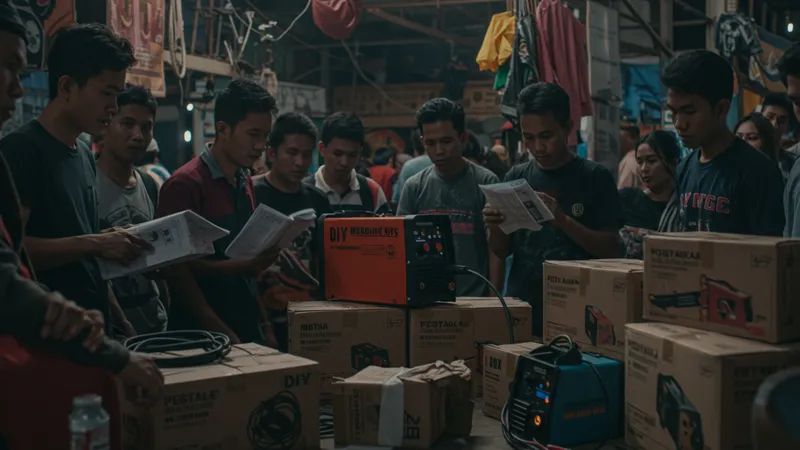
Additionally, there’s a contentious discussion around the export of these portable machines. Indonesia’s welding machines have attracted international interest, sparking a surge in export demands. While this is lucrative, there are fears of domestic shortages that could handicap local small businesses. Balancing between meeting international market needs and nurturing domestic potential is proving to be a complex and sensitive issue. There's further controversy around the pricing strategies adopted by manufacturers. Can they sustain equitable prices that benefit both the local artisan and the corporate buyer? The debate intensifies as market players weigh profit against their ethical obligations.
Moreover, a surge in patent filings suggests a race to innovate or capitalize on this industrial boom. Patents play a dual role: safeguarding innovation and possibly stifling it by generating monopolies. Some industry veterans argue that a lack of open-source designs could hinder technological pace, while others insist on the importance of protecting proprietary advances. The tension between open collaboration and protected innovation could have broad implications for technological growth. As patents become a hot topic, the extent to which they influence the market can sway industry dynamics in unexpected directions. Will the tug-of-war between these philosophies create deadlock or foster progress?
Network monopolies are causing quite a stir, too. Countries may focus on fostering domestic champions or leveraging international conglomerates to drive industry forward. Despite varied approaches, Indonesia faces decisions with far-reaching consequences. Will it nurture home-grown innovations or embrace global partnerships? The future of this industry could depend on strategic alliances that defy traditional norms. As these trends unfold, they provide a lens into a complex economic and cultural scenario characterized by rapidly shifting paradigms. Could these industry debates lead to innovative policy developments? Stay tuned, as the narrative is still being crafted.
As we look ahead, the future of portable welding machines in Indonesia appears bright yet filled with uncertainties. These machines have not only revolutionized the crafts and industries they touch but have also positioned themselves at the heart of Indonesia’s technological evolution. What lies ahead is an intriguing road of potential and potential pitfalls. As the demand for high-quality, precision-driven work increases, the portable welding machine industry will likely see further technological enhancements, incorporating AI and machine learning for more refined outcomes. However, this acceleration raises the question: can the human workforce keep pace with these technological advancements, or are we approaching a tipping point?
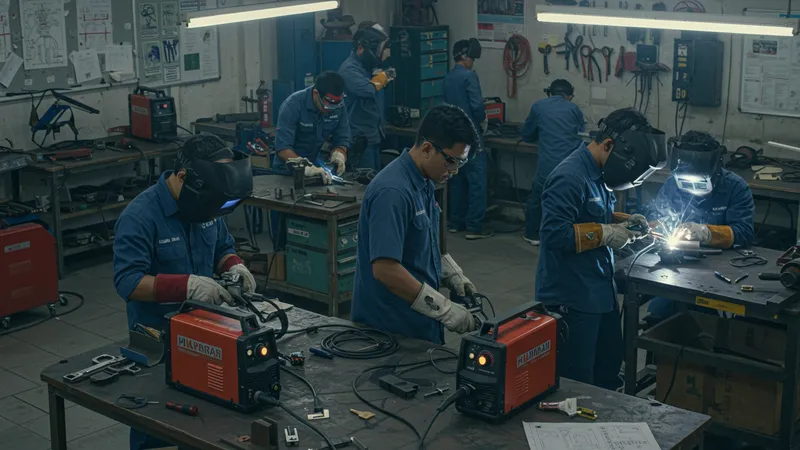
The future not only hinges on technology but also on sustaining the momentum in education and skill development. The government and educational institutions face the challenge of integrating welding training into more courses, ensuring the youth are prepared for a rapidly evolving industry. With skilled labor potentially becoming a premium, there is an urgent need to bridge the gap between traditional craftsmanship and high-tech welding techniques. Will the educational sector rise to the challenge, or will it watch as opportunities pass by? This is a pivotal intersection that could define future economic strategies.
Also looming on the horizon is the international front. As Indonesian products gain worldwide prestige, they stand on the brink of becoming key players in global markets. Aligning export strategies with domestic needs, Indonesia could transform into an influential player in the global supply chain. Targeting emerging markets might offer lucrative avenues, but such growth should not come at the expense of local initiatives. Balancing domestic priorities with international expansion remains a complex balancing act with time-sensitive strategic considerations.
Lastly, environmental sustainability will play a crucial role in shaping the industry's trajectory. Global trends highlight an increasing demand for eco-conscious production, prompting the industry to innovate green welding techniques and products. Integrating sustainable practices may require rethinking processes, and collaboration with environmental scientists might become the norm. Can the industry adapt, ensuring a lasting positive impact on both the economy and the environment? The coming years promise challenges, but with them comes the possibility of crafting a narrative of success that intertwines technology, craftsmanship, and sustainability, proving that the welding industry’s finest hour is yet to come.
Portable welding machines, beyond their functional capacity, are leaving an indelible mark on Indonesia’s cultural dynamics. In an era where tradition and modernity often clash, these machines offer a platform for blending elements of both worlds. Artisans are increasingly using welding to reinterpret traditional crafts, creating pieces that pay homage to their origins while speaking the language of modern design. This intersection fosters a unique cultural dialogue, elevating the national artisans' work on a global stage. It's a powerful narrative of identity preservation amidst technological transformation, an aspect often glossed over but central to cultural resilience.

Cultural transformation driven by welding machines extends into community dynamics, too. In regions characterized by a rich tapestry of ethnic diversity, these machines serve as catalysts for collaboration across cultural lines. Workshops and initiatives are not only about skill-building but also about fostering friendships and understanding among different Indonesian tribes. This intersecting of traditional know-how with modern aspirations reflects a microcosm of Indonesia’s broader journey towards unity in diversity. Can this foster sustainable peace and innovation, redirecting societal energies constructively? It's a hypothesis already visible in numerous community narratives.
Welding machines also inspire cultural pride, playing a role in identity affirmation for those discovering their creative potentials. The empowerment felt by artisans, especially women venturing into traditionally male-dominated fields, is rewriting gender narratives in many communities. Entrepreneurs who master welding craft traditions into business ventures are celebrated locally, elevating role models whose stories inspire others, facilitating cultural change through personal triumph. Yet, challenges of inclusivity and equal opportunity persist, raising questions on bridging divides without sacrificing cultural equity. Will these machines prove tools of empowerment across societal spectrums?
The artistic expressions emerging from these cultural interactions are gaining traction in international art circles. Indonesian artists using portable welders produce evocative works that inspire both appreciation and dialogue around craftsmanship and cultural history. Galvanizing interest abroad helps challenge stereotypes about Indonesian art, shifting perceptions towards a more nuanced and admired view. As these stories unfold, one can’t help but wonder what new forms of cultural discourse these machines might spark next. Through a peculiar lens, portable welding machines tell tales as complex and rich as their cultural impetus — a story of becoming, defying expectation.
The introduction of portable welding machines into Indonesia’s mainstream has catalyzed noticeable shifts within the educational landscape. These devices are transforming the approach to learning and skill acquisition, steering curriculums toward more hands-on, practical experiences. Schools and vocational training centers are increasingly incorporating welding programs to provide students with skill sets that have immediate market applicability. This curriculum shift signifies a notable cultural shift toward valuing technical skills alongside traditional academics, offering students alternative paths to white-collar jobs. Thus, welders are not merely laborers; they are artisans forging futures.
Educational reforms spurred by the welding machine boom are not merely about equipping the youth with skills but about fostering a passion for craftsmanship. Students exposed to these opportunities gain a practical understanding of metallurgy and physics, learning through doing. The satisfaction derived from creating tangible products with their own hands is immeasurable, promoting lifelong learning perspectives. This dual focus on practical and theoretical knowledge represents an educational evolution. However, educators face challenges merging diverse curriculums cohesively, and logistical constraints can stall implementation. Innovation at institutional levels is key to overcoming these hurdles.
On a broader scale, these machines contribute to changing societal perceptions about skill-based jobs. Where previously skilled trades were considered less prestigious, welding machines paint them as viable career paths. Mastery in welding becomes a symbol of competence and creativity. This new perception has prompted a shift in parental attitudes towards vocational education, which is increasingly seen as a smart career move rather than a fallback option. The evolving societal appreciation for tradespeople is integrating more family support structures around vocational careers. Such societal dynamics beg the question: how will this affect future generational job market trends?
While progress is evident, there remains a pressing need for equality in access to these educational opportunities. The divide between rural and urban education systems poses challenges that could widen skill gaps if unaddressed. Equal access to resources and training is critical to foster inclusivity and ensure that talent recognition does not become geographically limited. Partnerships between government entities, NGOs, and educational institutions are necessary to facilitate resource dissemination and training in underserved areas. As accessible welding training becomes more widespread, it might unlock untapped potential, bolstering Indonesia’s workforce diversity and dynamism.
Portable welding machines are not just altering industries; they’re transforming everyday lives across Indonesia. For the local garage mechanic or the home repair service, these machines have become indispensable. They provide practical solutions that enhance efficiency and productivity. The machines allow for quicker and more precise repairs, which in turn yield happier customers and growing businesses. This is particularly impactful in urban settings where time and efficiency are of the essence. However, the narrative doesn’t end here — these machines are indispensable tools in innovative applications that venture beyond typical usage scenarios.

For example, in the construction industry, portable welding machines play a pivotal role in onsite fabrication and assembly tasks, significantly cutting down repair times. Site managers attest to these machines' role in meeting tight deadlines and maintaining project flexibility. Additionally, the machines' role in disaster recovery is noteworthy. In emergencies requiring immediate structural repairs, portable welders enable quick, efficient responses, potentially saving lives and minimizing damage. These anecdotes highlight the machines’ versatility, sparking interest in their adaptability. What hidden potential might they unlock when paired with other innovative tools?
A particularly exciting development is the utilization of welding machines in creative industries. Artists and designers are harnessing these tools to explore new dimensions in sculpture and installations. Welding’s precision enables them to bring sophisticated creations to life, expanding the possibilities of artistic expression. This creative application showcases the machine’s dual capacity to serve both functional and artistic purposes, highlighting a novel intersection between craftsmanship and artistry. However, the challenge remains in balancing artistic freedom with technical constraints, a dialogue that continuously pushes the boundaries of what can be achieved.
Additionally, the machines facilitate skill-sharing initiatives. Communities are increasingly hosting workshops to teach welding skills, emphasizing empowerment through knowledge. These sessions foster resilience, providing individuals with marketable skills and strengthening community bonds. Such initiatives play a crucial role in stimulating local economies and constructing narratives of hope and self-sustainability. The impact of these skills extends beyond craftsmanship; they empower participants to envision alternative career paths. This optimistic perspective on vocational skill acquisition inspires curiosity about other ways welding machines can integrate into daily problem-solving contexts.
The burgeoning demand for portable welding machines in Indonesia has opened up global opportunities, creating a wave of interest from international markets. Nations eager to tap into Indonesia’s innovation have begun importing these machines, providing Indonesian manufacturers with unprecedented access to new markets. This expansion into global spheres promises economic dividends and increases collaborative prospects. Multinational partnerships can drive further technological advancements, enriching the industry. However, these opportunities are accompanied by challenges, particularly in aligning production quality with international standards. This necessitates continuous quality improvement and streamlined export processes.

International success depends significantly on maintaining competitive pricing strategies. Although portable welding machines have carved a niche with their affordable pricing models, rising production costs threaten this advantage. Global competition is fierce, with numerous players striving to offer cost-effective alternatives. Indonesian producers face the task of balancing cost efficiency with technological advancements. In an evolving industry landscape, how long can they maintain their competitive edge? Addressing these economic challenges requires innovative strategies and a robust understanding of market dynamics.
Simultaneously, international markets pose ethical challenges related to labor conditions and environmental sustainability. Ethical production practices are becoming integral to global competitive strategies. International consumers increasingly demand transparency and accountability, prompting Indonesian manufacturers to prioritize fair labor practices and environmentally friendly manufacturing. While these practices add operational layers, they could become pivotal differentiators in a crowded market. Are the industry and its players prepared to commit to these standards? Bridging ethical practices with economic goals will undoubtedly shape the sector moving forward.
The global scene is also a platform for cultural exchange. The proliferation of Indonesian welding machines facilitates cross-cultural dialogue, with opportunities arising for sharing techniques, designs, and philosophies. Such exchanges refine and redefine the landscapes of welding and craftsmanship, leading to enriched innovations and revitalized cultural narratives. But therein lies the challenge of preserving traditional identities amidst globalization. How can manufacturers and artisans maintain Indonesian cultural identities while embracing global influences? The fruits of this confluence — a mix of innovation, tradition, and ethical practice — await discovery in the unfolding story of global engagement.
Small businesses at the heart of Indonesia’s economy play a critical role in driving the evolution of portable welding technology. These enterprises are agile, rapidly adopting new tools and techniques that larger corporations may overlook. As small-business owners experiment with advanced welding techniques, they pave the way for broader industry adaptations. This grassroots innovation approach not only democratizes technology but also catalyzes industry-wide transformations. It’s a strategy characterized by prompt adaptation, local needs, and creative problem solving, illustrating the capacity of small enterprises to lead meaningful change.
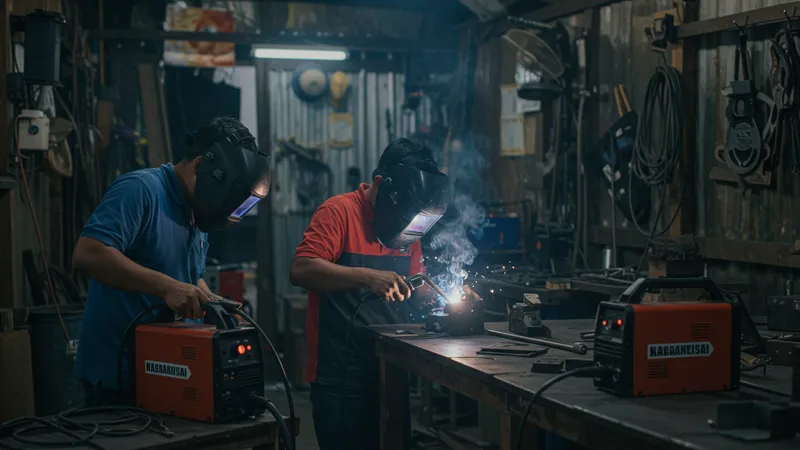
The responsiveness of small enterprises is propelled by the necessity to remain competitive and relevant amid fast-changing markets. They treat welding machines not just as tools but as catalysts for rethinking service delivery models. By integrating them into innovative business practices, owners are setting benchmarks for efficiency and service improvement. These enterprises are leveraging technology to scale operations, expand services, and access broader markets. But, the real game-changer comes from understanding their collective power. Could small businesses setting collective standards redefine the industry at large?
Interestingly, collaborations between these enterprises and educational institutions are heralding a new era of vocational training and employment pathways. By connecting industry and academia, new blueprint solutions for skill development and workforce readiness emerge. Such collaborations foster environments conducive to experimentation, encouraging the incubation of groundbreaking ideas. Through shared knowledge, they address skill gaps and provide young professionals with platforms to showcase their talents. This model of cooperation highlights the potential for innovation catalyzed by synergizing effort and maximizing available insights. Does the answer to broader technological advancements lie in such collaborations?
However, these enterprises face significant hurdles, such as accessing finance and market share. While innovation is central to their business model, financial constraints often limit their potential to scale and invest in innovative projects. Addressing these challenges involves a collaborative approach from financiers, policymakers, and industry leaders to create enabling environments. What solutions can ignite a new era of tech-driven enterprise growth? Exploring partnerships and innovative financing will be key to unlocking these businesses' full potential. The lessons learned will determine the balance of enterprise agility and scalability, with implications rippling outwards to influence the entire sector's trajectory.
The COVID-19 pandemic reshaped industries worldwide, and the welding machine market in Indonesia was no exception. Amidst shifting paradigms, these machines rose as unlikely heroes in a time of crisis, playing a pivotal role in recovery efforts. With supply chains disrupted and traditional manufacturing hampered, portable welders enabled flexible production models, facilitating localized operations swiftly. This adaptability proved crucial for industries such as healthcare, which required rapid production of essential equipment. The pandemic spotlighted these machines' indispensability, and with it came an unexpected opportunity for industry-wide introspection and re-strategizing.
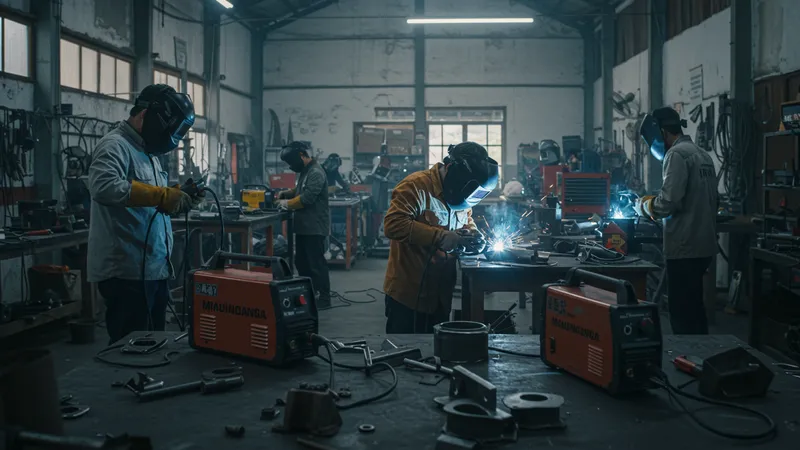
The surge in demand during the pandemic revealed latent vulnerabilities within the supply chains. Manufacturers scrambled to meet unprecedented demand, exposing gaps in supply chain logistics and resource allocation. These revelations catalyzed a shift toward more resilient and self-sufficient manufacturing models. Enterprises reconsidered their dependency on centralized production, inspiring them to decentralize and distribute production processes. This new operational paradigm implies a fundamental industry shift towards more sustainable and resilient frameworks. Will these adaptive strategies become mainstays in a post-pandemic world?
Moreover, the pandemic disrupted traditional marketing approaches, urging companies to pivot toward digital solutions. Virtual trade shows, online product demonstrations, and social media marketing became integral for engaging consumers. The digital overhaul presented manufacturers with fresh insights into consumer behavior and preferences, accentuating the need for a robust online presence. These digital strategies look set to transform traditional market engagement models. The question remains: how will sustained digital engagement influence the industry’s evolution and consumer relationships?
In parallel, the pandemic underscored the importance of resilient workforce structures and flexible business models. Companies revisited operational flexibility, adjusting to remote work capabilities and hybrid models where feasible. The pandemic illuminated workforce dynamics, emphasizing employee well-being as much as productivity. Companies that prioritized adaptability and employee engagement gained a competitive edge. But as we anticipate a post-pandemic landscape, how will firms balance the newfound adaptability with the traditional values that underscore craftsmanship? This ongoing interplay between modern flexibility and timeless skills will continue to shape sector dynamics as the world adjusts to new realities.
As the welding machine market burgeons in Indonesia, environmental considerations necessitate innovative responses. With sustainability becoming an essential facet across industrial sectors, welding machines are joining this eco-conscious revolution. Manufacturers are exploring clean energy solutions, such as solar-powered welding machines, aiming to reduce carbon footprints while maintaining operational efficiency. These forward-thinking approaches don't only benefit the environment; they promise significant economic advantages through reduced long-term operational costs. Yet, to what extent will these initiatives redefine industry norms?
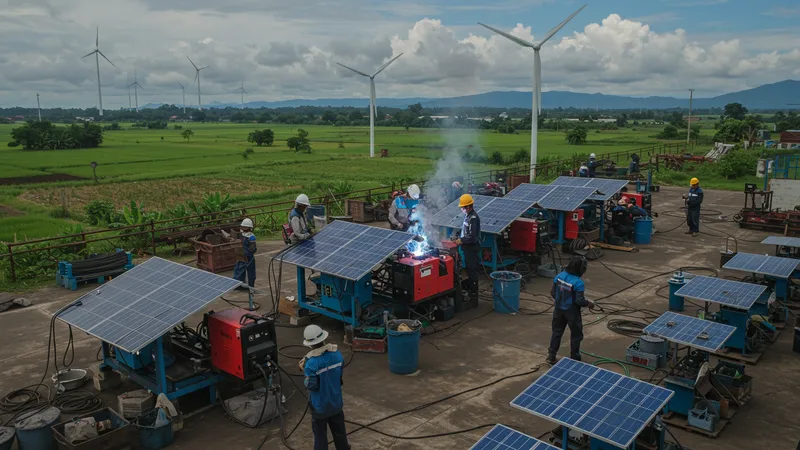
The transition toward eco-friendly practices is supported by advances in recycling technologies, enabling the effective reuse of welding materials. The promise of closing the loop on material cycles prompts automation within the manufacturing processes. Efficiency gains align with the global trend toward circular economies, however, implementing advances remains challenging. Smoother transitions necessitate considerable investment and strong collaboration among stakeholders. Will the industry embrace these green innovations fully, setting the stage for protected environmental futures?
Sustainability is further marked by shifts in product longevity and durability. Manufacturers are innovating materials that extend the lifespan of welding machines and reduce the need for frequent replacements. The shift toward durable craftsmanship suggests a broader consumer shift toward quality over quantity. Extended usability presents environmental benefits by reducing waste, and it further aligns businesses with eco-aware consumer markets. With planned obsolescence becoming less attractive, can the welding industry leverage sustainability as a competitive edge moving forward?
Nevertheless, achieving sustainability is not without challenges, as these upgrades demand substantial infrastructural and operational adjustments. Industry actors must grapple with complex logistical changes and transitions in workforce skill requirements. There are opportunities for success through meaningful strategic partnerships and transparency in the supply chain. The responsibility lies in industry leaders to drive the conversation around green practices — advocating for a cohesive industry approach that aligns with global sustainability goals. The question lingers: will economic imperatives align with environmental priorities, fostering an era of eco-conscious industrial innovation?
Remarkable innovations are emerging from unexpected regions within Indonesia, revolutionizing the way portable welding machines are utilized. In Eastern Indonesia, for example, creative use of welding technology is transforming local industries. Communities are crafting solutions tailor-made for specific regional challenges, such as welding-based water conservation systems. These micro-innovations demonstrate resilience and creativity, proving that necessity indeed drives innovation. Such localized developments have the potential to catch on nationwide, inspiring similar advancements elsewhere. Will these grassroots innovations become catalytic forces for broader industry evolution?

Indonesia's wealth of artisanal traditions complements high-tech welding innovations, offering hybrid solutions to complex problems. Craftsmen are blending technology and tradition to create products rooted in authenticity and practicality. These interdisciplinary applications foster cooperative environments where stakeholders share insight and experience, leading to enriched insights and groundbreaking practices. These bold intersections encourage others in the industry to experiment and push boundaries, promoting knowledge sharing. This fusion of tradition and modernity prompts growth beyond traditional constraints, but challenges remain in scaling these initiatives to reach wider markets.
Universities and research centers are joining the innovation movement by partnering with local businesses to develop strategic welding technologies. These collaborations yield sophisticated engineering solutions and student-led projects are creating pathways to address real-world challenges. The creation of university-industry consortia reflects a growing recognition of the value inherent in these knowledge partnerships. By linking academic ambitions with industry needs, Indonesia nurtures a generation of tech-savvy professionals ready to tackle pressing societal and industry challenges. But how robust will these alliances remain amidst evolving educational and industry landscapes?
However, challenges loom, particularly regarding resource allocation and systemic integration. Balancing short-term immediate benefit with long-term strategic planning is crucial for maintaining momentum. Diverse entities must navigate the balance between rapid technological adoption and preserving their cultural strengths, ultimately fostering an innovative ecosystem. New policy frameworks and investment guidelines could support the aspirations of these innovative communities. At the heart of this question lies the balancing act: can Indonesia cultivate an environment conducive to stimulating innovations that bridge past and future while overcoming inherent challenges?
As the portable welding machine market continues to evolve and flourish in Indonesia, the impacts resonate throughout economic, cultural, and technological spheres. This fascinating journey defies expectations and showcases human resilience in harnessing technology for diverse applications. The welding machines symbolize more than just mechanical prowess; they embody an ever-changing narrative of creativity, entrepreneurship, and social transformation that captivates local and global audiences alike. The drive to enhance these tools for broader applications highlights the potential that remains yet untapped.
The ongoing developments hold valuable lessons, calling upon governments, businesses, and educational institutions to collaborate and nurture a sustainable, equitable industry. By addressing challenges and seizing opportunities, stakeholders can ensure a promising future. That’s why it’s vital for those involved to remain engaged with these dynamic trends and embrace the transformative potential that portable welding machines represent. We invite you to share this story, bookmark it for future updates, and take a role in crafting the next chapter of Indonesia’s welding machine saga. Let’s shape a future where creativity and technology unite to inspire unprecedented change.